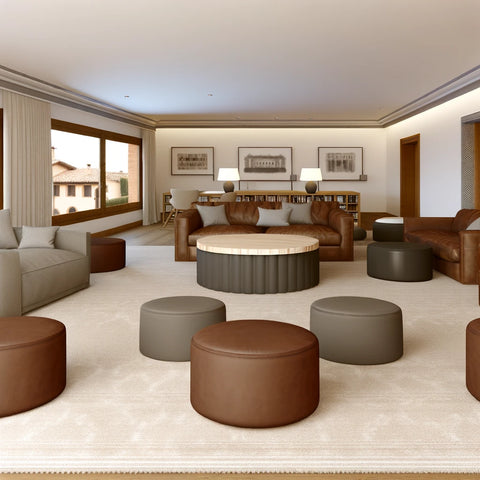Interior Design - Inspiration - Furniture Tips and more
Guide to Arranging Your Living Room Furniture for Optimal Comfort and Style
Arranging the living room furniture is an art that combines functionality with personal aesthetics, aiming to create a welcoming and comfortable space. Whether you're revamping your space or starting from scratch, understanding the principles of furniture arrangement can transform your living room into a harmonious and inviting area. This guide will walk you through the essential steps to achieve the best results, keeping in mind your lifestyle, budget, and design preferences.

Establish a Focal Point
The focal point is the heart of your living room, dictating the arrangement of furniture. It could be anything from a large window with a stunning view, a fireplace, an artwork, or the television. Once you've identified your room's focal point, arrange the furniture to complement it, ensuring the focal point is visible and highlighted. For rooms without a natural focal point, create one using a large piece of art or a media unit, and arrange your seating around it.
Create Conversation Areas
Your living room should invite conversation, with a layout that makes it easy for people to communicate comfortably. Arrange sofas, chairs, and ottomans to form intimate gathering areas, keeping the seating close enough to foster easy conversation but with enough space to move around. For larger rooms, consider creating multiple conversation areas, each with its own focus and seating arrangement.
Balance Your Furniture
Achieving balance in your living room is key to creating a visually appealing space. Distribute the visual weight of your furniture evenly throughout the room, mixing large and small pieces rather than clustering similar sizes together. Balance can also be achieved by mirroring furniture arrangements on either side of a central axis or focal point, adding symmetry and cohesion to the space.
Ensure Flow of Movement
Your living room should allow for easy movement, with clear paths between furniture pieces and around the room. Aim for about 70-120 cm of walking space around main traffic routes and ensure there's sufficient space between seating and coffee tables for comfort. The layout should facilitate an unobstructed flow from one area of the room to another, enhancing the overall functionality and accessibility of the space.
Consider the Rug Placement
Rugs can anchor your living room, defining the seating area and adding warmth and texture. Place your rug so that it either fully encompasses your seating area or at least the front legs of your sofas and chairs rest on it. This creates a cohesive look and visually ties the furniture together.
Choose the Right Size Furniture
Select furniture that fits the scale of your room. Oversized pieces can overwhelm a small space, while furniture that's too small can look lost in a larger room. Consider the proportions of your room and the size of your furniture to ensure they complement each other, creating a balanced and comfortable living area.
Add Accent Pieces
Accent pieces like side tables, ottomans, and bookshelves not only provide functionality but also add character and interest to your living room. Use these pieces to fill empty spaces, add storage, or inject color and texture into the room. Be mindful of their placement, ensuring they contribute to the room's flow and balance.
FAQs
-
How far should the sofa be from the TV? Aim for a distance of about 3-4 meters, adjusting based on your screen's size and your seating comfort.
-
Can I use an ottoman as a coffee table? Yes, ottomans can double as coffee tables, offering versatility and comfort. Consider using a tray for stability when placing drinks or remotes.
-
How do I make a small living room appear larger? Use mirrors to reflect light, choose furniture with exposed legs, and opt for light-colored walls and furnishings to create the illusion of space.
-
What's the best way to light a living room? Combine various lighting sources, such as overhead lighting, floor lamps, and table lamps, to create a warm and layered lighting scheme.
-
How do I balance a room with high ceilings? Utilize tall bookcases or artwork to draw the eye upwards, and incorporate vertical elements to balance the space's height.
-
Can I mix different furniture styles? Absolutely, mixing styles can add depth and interest to your living room. Keep a cohesive color scheme or element to tie the different styles together.
By following these guidelines, you can create a living room that not only looks great but also feels welcoming and comfortable. Remember, the key to a successful living room design is balancing aesthetics with functionality, ensuring your space meets your needs while reflecting your personal style.
Buying the right furniture makes the work easier and more satisfying. Figure out the most essential items to avoid clutters. Get exquisite and practical pieces online at Prestige Affairs Furniture.
















